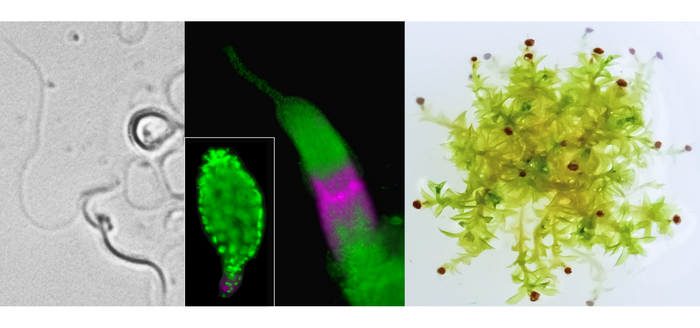Mosses, as a component of moors, play an important role in climate conservation and are gaining significance in biotechnology and biopharmaceutical production. They are also interesting research subjects due to their similarity to early land plants, providing insight into the original function of growth and development signaling molecules used by all land plants today. Researchers at the University of Freiburg and the Excellence Cluster CIBSS have discovered that the hormone auxin transporters influence the fertility of spreading earthmoss, as published in the journal New Phytologist.
Auxin and PIN proteins regulate fertility
The hormone auxin is found in all land plants and plays a crucial role in regulating growth and development. The molecules that transport auxin, known as PIN proteins, also play a significant role in controlling its distribution. The moss Physcomitrella, also known as spreading earthmoss, has three different PIN proteins. Two of them are important for leaf and shoot growth, but the function of the third protein, PINC, was previously unknown. Studies have now shown that spreading earthmoss that do not have PINC grow in a normal manner.
Researchers have discovered that PINC plays a dual role in influencing the fertility of Physcomitrella. They conducted experiments by exposing the plants to low temperatures and short light periods, under which the species develops both female and male sex organs. These conditions helped them to understand the significance of PINC in the fertility of Physcomitrella.
Sperm swim better without PINC
The study’s first author, Volker Lüth, a doctoral candidate in Reski’s lab, states that in Physcomitrella plants where PINC was absent, more sperm were able to swim and had straight rather than coiled flagella. Unlike nearly all other land plants, mosses have sperm that propel themselves with flagella and must swim through drops of water to reach the female sex organs. The fact that PINC reduces the fertility of sperm is surprising, as poor swimmers are at a disadvantage. Reski suspects that this may be because the lab plants are generally less fertile than their wild relatives. Regardless, the results of the study show for the first time that auxin in spreading earthmoss plays a role in the maturation of sperm, also known as spermatogenesis.
Spore capsules are lost without PINC
PINC has the opposite effect on the attachment of the spore capsule, which is the structure that develops from a fertilized egg. In Physcomitrella, it remains attached to the female organs where it is supplied with nutrients. If the attachment breaks, it is equivalent to the abortion of an embryo, according to Reski. He states that if PINC is absent in mosses, abortions occur more frequently. A significant aspect of this process is the brown ring-like structure that encircles the foot of the spore capsule. This structure had not been named until now, it was last described in 1909 by German botanist Wilhelm Lorch. Lüth states that it is called the Lorch ring, and it integrates auxin signals with the mechanical characteristics for securing the spore capsule.
“You really have to take a very close look”
In retrospect, the researchers say that the function of PINC remaining unknown for so long was not surprising. Reski explains that they did not suspect that auxin or the auxin transporting PIN proteins played a role in the fertility of mosses and that the effect is limited to microscopic structures which requires a close examination. He hopes that further research on mosses and other plants can build on these results and open up a new research field.
Factual overview:
- Original publication: Volker M. Lüth, Christine Rempfer, Nico van Gessel, Oliver Herzog, Melanie Hanser, Marion Braun, Eva L. Decker, Ralf Reski (2022). A Physcomitrella PIN protein acts in spermatogenesis and sporophyte retention. In: New Phytologist. DOI:10.1111/nph.18691.
- Ralf Reski is a professor of plant biotechnology at the University of Freiburg and a member of the Clusters of Excellence the Centre for Integrative Biological Signalling Studies (CIBSS) and Living, Adaptive and Energy-autonomous Materials Systems (livMatS). His research emphasis is on molecular biology and the biotechnology of mosses. Website: https://plant-biotech.net/
- The study was supported by the German Research Foundation (DFG).




